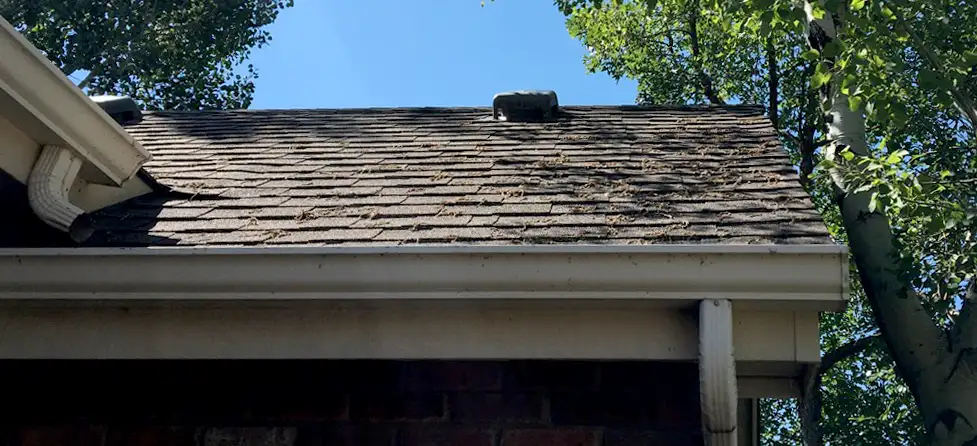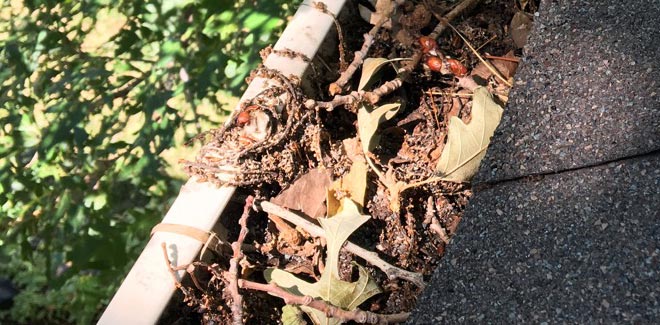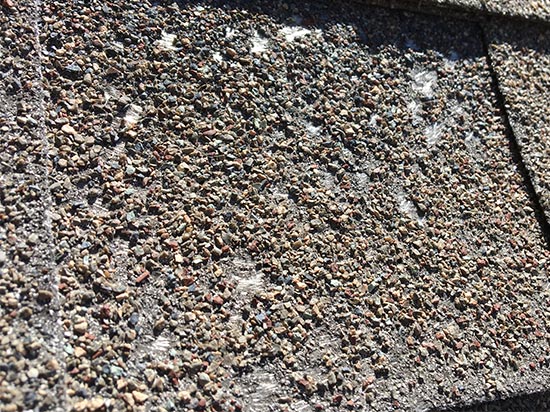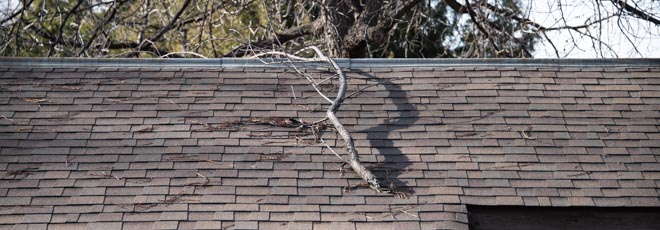Why is Spring Roof Maintenance Important?
Spring in Colorado means rain, and often high winds. If your roof is in good working order, you have nothing to worry about. However, if you have a loose shingle, or unsealed flashing, or missing roof material, you will likely have bigger problems soon. Loose roofing material has a domino effect – once one is loose, others will follow. A leaking roof leads to more problems, such as water in your attic, electrical shorts, mold in your attic, stains on your ceiling, the list goes on and gets expensive the longer you delay fixing that minor roof problem. As part of your Spring roof maintenance, it’s important to catch potential problems right away.

Spring Impact on Your Roof
Spring is a hard time of year for your roof in Colorado. During the Spring, we’ll see all four seasons in one month with freezing temperatures, heavy wet snow, driving rain, hail, strong winds, and warm sunny days. Temperatures will fluctuate greatly in the Spring. Roofing materials will expand and contract, swell and shrink. It’s a great time of year for problems to arise with your roof. Even new roofs can reveal problems in the Spring. That’s why it’s a great time for Spring roofing maintenance and to inspect your roof or have it inspected. It’ll be good to make sure your roof is ready for the harsh, demanding Colorado Spring.
- Check Gutters
- Missing or Loose Roof Material
- Check For Granule Loss
- Cracked or Curled Shingles
- Remove Debris
- Trim Low-Hanging Tree Branches
- Check Flashing
- Repair Quickly
Check Your Gutters

Gutters and downspouts are there to divert rain away from your roof and home. If they are clogged, they can’t do their job. A clogged gutter or downspout is like a dam, holding water back, preventing it from flowing where it should. With enough water behind that dam, your gutters may become too heavy and tear from your house. A clogged gutter could also cause rain to over your gutter instead of down them. Your gutters and downspouts should also be a part of your spring roof maintenance. Make sure they’re clean so water can easily flow off your roof and away from your home, protecting your foundation.
Roof Check
An important part of your spring roof maintenance is to check your roof for potential leaks. Common potential leaks include missing or unsealed roof material, such as shingles or flashing, and holes in seals or the roofing material. Make sure any roofing material, such as shingles or flashing are secured-down and sealed. A good time to check for loose or unsealed roofing material is when it’s windy. Strong winds will often lift-up loose asphalt shingles. Strong enough windows will lift-up steel shingles or sheets. Missing roofing material, unsealed roofing material, unsealed flashing, holes in flashing or roofing material, are leaks waiting to happen. If you see any potential leaks, it’s in your best interest to fix them right away before a bigger problem develops.
Granule Loss

Check for excessive granule loss on an asphalt shingle roof, as part of your spring roof maintenance. Granules on an asphalt shingle roof looks like little rocks. They protect the shingles from UV radiation. Without them, your shingles would rapidly deteriorate. Excessive granule loss is a sign your roof is old and needs replacing. You’ll know you have excessive granule loss if you regularly see them in your gutters or on the ground around your downspouts. On the shingles, where granules once were, you’ll see shiny spots.
Cracked or Curled Shingles

Check for excessive cracked or curled asphalt shingles. Shingles crack from extreme temperature changes. This crack is usually limited to the surface of the shingle and doesn’t go all the way through it. Shingles curl when the adhesive beneath them dries. This is common with old shingles or poor quality ones. A cracked or curled shingle is a compromised one and one that’s prone to leaking. A curled shingle looks like a curled potato chip. A cracked shingle will have an natural black jagged line running down it. If you notice any cracked or curled shingles, you want to replace them as soon as possible, as they are a potential water leak.
Debris

It’s common for leaves to fall onto roofs and build-up in roof valleys. Spring is normally a wet time of year in Colorado. Accumulated debris, such as leaves, should be cleared from your roof as part of your spring roof maintenance. If left ignored, those leaves will become wet and will eventually rot, which will lead to your roof deteriorating quicker.
Tree Branches

In the Autumn and Spring, we often get strong winds in Colorado. We also get heavy, wet snow in the Spring. If you have trees hanging over your roof, and wet snow piles on top of them, those branches may have fallen onto your roof. You’ll want to remove those fallen branches to check for any damage they may have caused and to prevent any further damage. Small fallen tree branches may not have caused any damage. Medium-size branches may have cause minor damage, such as a dent on a metal roof, or minor granule loss on asphalt shingles. Large branches, however, could have punctured a hold in your roof or torn roofing material away. Regardless, you’ll want to get on your roof to assess the damage and remove those fallen tree branches.
Trim Overhanging Branches
Spring is a time of growth. Tulips and crocuses are popping-up all up and down the Colorado Front Range. Trees will also grow. If you have any tree branches close to your roof, or hanging over your roof, they will most like grow to rub on your roof. It’s in your best interest to trim those branches back while performing your spring roof maintenance so they can’t rub or fall onto your roof later this Spring.
Attic
Some roof problems don’t have anything to do with your actual roof. Some have to do with a poorly ventilated attic. As part of your Spring roof maintenance, be sure to also check your attic for mold. If you spot any, you might have a leaking roof and/or a poorly vented attic. If you have mold in your attic, you might be able to cover and terminate it with products such as Killz from your local hardware store. If your attic isn’t being vented properly or sufficiently, we can help.
Mold and Mildew
Check for mold, algae and mildew on your roof. It looks like black or green streaks or blotches on your roof. Mold, mildew, and algae can prematurely breakdown your roof. If your roof has minor mold, mildew, or algae, you might consider spraying your roof with a mix of water and bleach. However, if the majority of your roof has this problem, you might want to consider a new roof – one that’s more resistant to this problem.
Flashing
Flashing is a thin strip of metal that helps protect your roof from the elements. It’s an integral part of every roof. You’ll find flashing at the edges of shingles, at the roofline, and around vents, chimneys and pipes. Just like other roofing material, if it’s damaged or not sealed, it’s susceptible to leaking. As part of your Spring roof maintenance, don’t forget to inspect the flashing.
Soffit and Fascia

Examine your soffit and fascia. What are those, you ask? Soffits are the surfaces under your roof between the wall and the roofline. Fascias are the vertical surfaces where most gutters are attached to. When a gutter tears away from your home, due to neglect, it frequently takes the fascia with it. If you notice the fascia starting to pull away, get that fixed right away. If you notice a swelling soffit, this is probably due to an inefficiently vented attic. That, too, you’ll want to fixed as soon as possible.
Repair Quickly
If you spot any problems on your roof or in your attic, you’ll want to repair it right away. A small problem, if ignored, will grow into a bigger, most expensive problem later. We’ve repaired small holes in roofs very affordably. Had that hole not been patched, water would have gotten into the attic, potentially caused electrical shorts, definately would have caused major interior water damaged to the attic and ceiling.
Roof Inspection
When we inspect roofs for free, there’s no reason not to get one. If you’re worried a roofing company will inspect your roof and find problems when there aren’t any just to get some work, you don’t have to worry about this with us. We will honestly let you know if your roof is good to go, if it’s in need of minor or major repair, or if it needs replacing. We haven’t become one of Colorado’s most trusted roofing professional by being dishonest to people. We’ll let you know if your roof is in need of spring roof maintenance.
Spring Roof Maintenance FAQs
Q. What time of year do most roofing problems show themselves?
A. Most roofing problems show themselves during a storm. Loose roofing materials are often obvious during strong winds. Spotting a leaking roof can be tricky, since water can travel down rafters.
Q. What are the most common spring roof problems?
A. Damaged or sagging gutters, leaves left in valleys of roofs over the Winter, tree branches that have fallen onto roofs from the weight of heavy snow. Most of these problem are avoidable if one cleans their gutter and removes fallen branches from their roofs.
